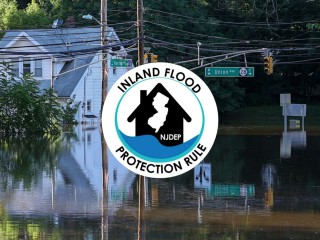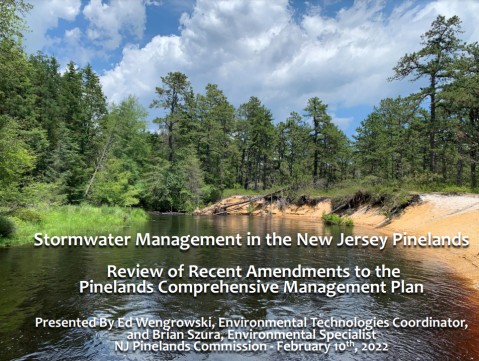Proposed Inland Flood Protection Rule
The New Jersey Department of Environmental Protection ("NJDEP" or the "Department") has proposed an "Inland Flood Protection Rule" ("IFP" or the "proposal") that would result in substantial changes to its existing flood hazard area and stormwater management rules.This proposal would revise requirements only for fluvial areas (non-tidal areas in the proximity of rivers and streams) impacted by stormwater runoff.
Flood Hazard Area Control Act Rule Amendments
Where NJDEP or FEMA flood mapping is available, applicants would use existing mapping with the increased safety factor described above. However, if an applicant disagrees with the available flood mapping or where none is provided, "Method 6", as outlined in proposed amendment N.J.A.C. 7:13-3.6(c), provides a framework by which the design flood elevation and floodway limits can be calculated by a licensed professional engineer using the applicant's own hydrologic and hydraulic analysis.
Additionally, proposed amendments to N.J.A.C. 7:13-6.7 provide that structures authorized pursuant to "permit-by-registration," "general-permit by certification," or "general permit" are required to comply with applicable design and construction standards of the Uniform Construction Code under N.J.A.C. 5:23, and the Federal flood reduction standards under 44 CFR Part 60. These requirements mirror the NJDEP's Coastal Zone Management rules at N.J.A.C. 7:7-9.25(f) regarding activities falling under a coastal permit or flood hazard area.
Proposed amendments at N.J.A.C. 7:13-12.6 provide flexibility in compliance for public roadways and railroads used by motor vehicles or trains that are intended for public use and developed on behalf of a public transportation entity (a governmental entity or statutorily authorized public-private partnership program). The NJDEP believes this flexibility is warranted because public roadways constructed by public entities are subject to unique placement constraints that can impact the ability of such a project to comply with stormwater requirements.
Notably, the Department states in the proposal that such unique circumstances are not present in roadways constructed as part of a private development project. Thus, roadways constructed as part of a private development project by a private entity will be subject to the new elevation requirements. This will impact the location and design of access points and private roads in new developments and developments proposed for expansion.
Stormwater Amendments
Accordingly, use of existing methodologies for computation of hydrographs (used to show water level rates over time) as provided under the current rules would be discontinued as the NJDEP believes these methods are based on an "oversimplification" of complex hydrological processes.
Additionally, there is a certain degree of flexibility provided for major developments associated with public roadways and railroad projects conducted by public transportation entities. Under new rule at N.J.A.C. 7:8-1.6(f), projects that have determined a preferred alternative or reached an equivalent planning and design milestone before the effective date of the rule proposal will not be required to utilize the proposed precipitation change factors for purposes of demonstrating compliance with the Stormwater Management rules. Where, however, a public transportation entity selects a new preferred alternative (or equivalent) for a project after the effective date of the rule proposal, the entity must comply with the stormwater standards effective at the time the project's applicable permit is found complete for review.
Finally, note that the NJDEP stormwater amendments do not amend or supersede the amendments to the Pinelands Comprehensive Management Plan Stormwater Management Rules that took effect for compliance purposes in January 2023.
There Are Grandfather Provisions
Flood Hazard Area Rule Grandfather Provisions
Pursuant to proposed new N.J.A.C. 7:13-2.1(c)1, applications for development in currently regulated areas deemed "complete for review" prior to the effective date of the new rules are exempt from the new rules.
Pursuant to proposed new N.J.A.C. 7:13-2.1(c)4, activities in areas currently outside of NJDEP jurisdiction that will be regulated under the new rules are exempted from application of the new rules but only if:
(1) The activity falls completely outside of the current Flood Hazard Areas as of the rule's effective date;
(2) Construction has actually commenced to the point that the activity could not practically be modified and the activity has received all necessary federal, state, and local approvals such that construction could have lawfully commenced prior to the effective date of the rule proposal.
Stormwater Rule Grandfather Provisions
Under proposed amendments to N.J.A.C. 7:8-1.6(2),(3) and (4)i and ii, in order to have the current stormwater rules apply, the permit applicant must have submitted a technically complete application to the NJDEP prior to the effective date of the new rules.
What is the Impact on Development?
The public comment period regarding the rule proposal concluded on February 3, 2023. The NJDEP has not announced when the rules would take effect, although there are indications it may be in early June, 2023. We will continue to monitor the proposal as it moves through the regulatory process and provide updates on any new developments.
On the Horizon for Coastal Areas...
NJDEP is planning to propose the New Jersey Protecting Against Climate Change ("NJPACT") Resilient Environments and Landscapes ("REAL") which the Department states will "incorporate climate change considerations, like sea level rise, into the environmental land use rules including the Coastal Zone Management Rules, the Freshwater Wetlands Rules, the Flood Hazard Area Rules, and the Stormwater Management Rules". More information is available at https://dep.nj.gov/njpact/.
**The above discussion is intended to provide general informational guidance regarding the proposed Inland Flood Protection Rule and should not be relied upon as a substitute for competent advice from experienced attorneys and other appropriate professionals relative to a specific application or matter before the NJDEP or other entity.
By accepting you will be accessing a service provided by a third-party external to https://www.ndglegal.com/





